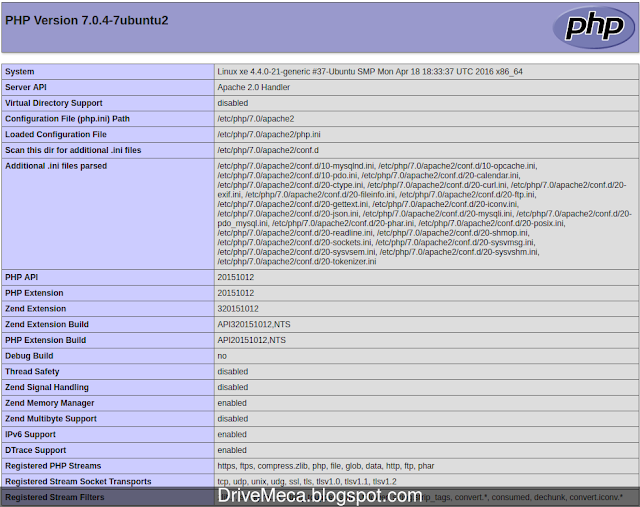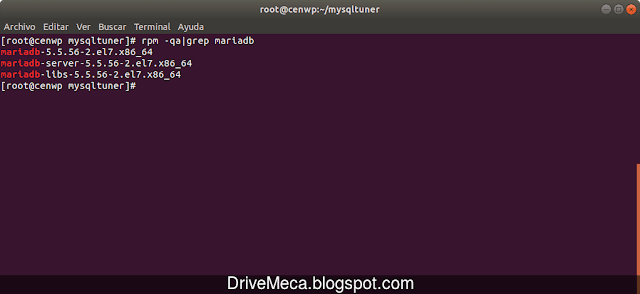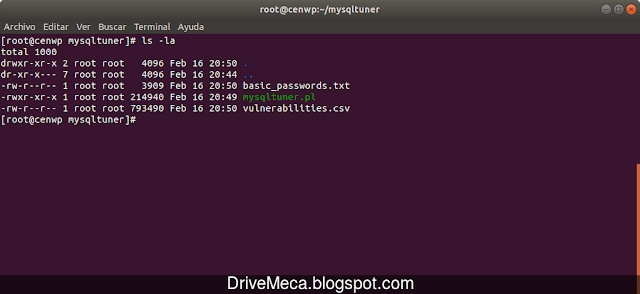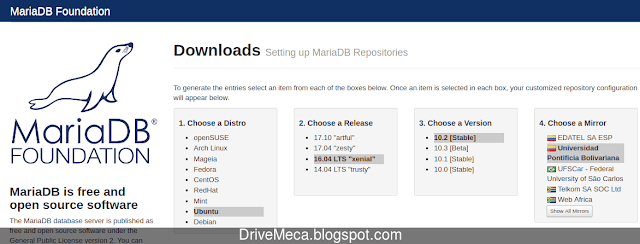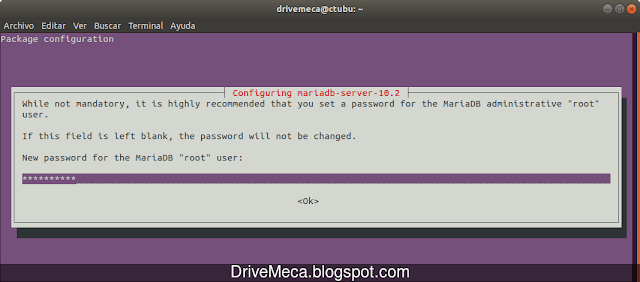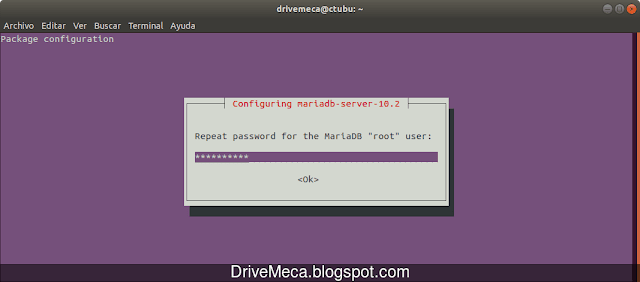Una de las formas mas comunes en que usamos nuestros servidores Linux es sirviendo paginas web como por ejemplo instalando algún CMS como WordPress, Joomla, Drupal entre otros. Esta configuracion es conocida como LAMP y viene de las iniciales Linux-Apache-MySQL/MariaDB-PHP.
Para este articulo veremos como instalar y configurar un servidor Linux Ubuntu 16.04 LTS en modo LAMP (en vez de MySQL usaremos MariaDB) paso a paso de la forma mas sencilla y rápida.
Debo aclarar que LAMP no solo se ve en Linux Ubuntu, en todas las distribuciones Linux podemos instalar y configurar gracias a la "magia" del opensource con relativamente pocos cambios. Comencemos entonces con otro articulo de Ubuntu en español
Para este articulo veremos como instalar y configurar un servidor Linux Ubuntu 16.04 LTS en modo LAMP (en vez de MySQL usaremos MariaDB) paso a paso de la forma mas sencilla y rápida.
Debo aclarar que LAMP no solo se ve en Linux Ubuntu, en todas las distribuciones Linux podemos instalar y configurar gracias a la "magia" del opensource con relativamente pocos cambios. Comencemos entonces con otro articulo de Ubuntu en español
Requerimientos para instalar LAMP en Linux Ubuntu
- Linux Ubuntu server LTS
- Activar ip fija para Linux Ubuntu server
- Conexión a internet
Como instalar LAMP en Linux Ubuntu server paso a paso
Instalamos dependencias
-Abrimos una consola e instalamos apache, mariadb y php en su versión 7
sudo apt install apache2 mariadb-server php7.0-mysql php7.0-curl php7.0-json php7.0-cgi php7.0 libapache2-mod-php7.0
sudo systemctl enable apache2
sudo systemctl start apache2
-Verificamos este ejecutándose el servicio de Apache 2
sudo systemctl status apache2
● apache2.service - LSB: Apache2 web server
Loaded: loaded (/etc/init.d/apache2; bad; vendor preset: enabled)
Drop-In: /lib/systemd/system/apache2.service.d
└─apache2-systemd.conf
Active: active (running) since dom 2016-05-01 17:22:24 COT; 24min ago
Docs: man:systemd-sysv-generator(8)
CGroup: /system.slice/apache2.service
├─11573 /usr/sbin/apache2 -k start
├─11576 /usr/sbin/apache2 -k start
├─11577 /usr/sbin/apache2 -k start
├─11578 /usr/sbin/apache2 -k start
├─11579 /usr/sbin/apache2 -k start
└─11580 /usr/sbin/apache2 -k start
may 01 17:22:23 xe systemd[1]: Stopped LSB: Apache2 web server.
may 01 17:22:23 xe systemd[1]: Starting LSB: Apache2 web server...
may 01 17:22:23 xe apache2[11555]: * Starting Apache httpd web server apache2
may 01 17:22:24 xe apache2[11555]: *
may 01 17:22:24 xe systemd[1]: Started LSB: Apache2 web server.
may 01 17:46:52 xe systemd[1]: Started LSB: Apache2 web server.
-Abrimos un browser en otro pc dentro de nuestra LAN y navegamos a la ip del servidor Linux
Ya tenemos activo nuestro Apache2
Articulo recomendado: Como instalar interfaz grafica en Ubuntu server paso a paso
sudo mysql -u root
use mysql;
update user set plugin='' where User='root';
flush privileges;
quit;
-Aseguramos nuestra instalación de MariaDB colocándole contraseña a la cuenta root de MariaDB. Solo escribimos la contraseña y las demás preguntas las dejamos con el default presionando Enter
sudo mysql_secure_installation
NOTE: RUNNING ALL PARTS OF THIS SCRIPT IS RECOMMENDED FOR ALL MariaDB
SERVERS IN PRODUCTION USE! PLEASE READ EACH STEP CAREFULLY!
In order to log into MariaDB to secure it, we'll need the current
password for the root user. If you've just installed MariaDB, and
you haven't set the root password yet, the password will be blank,
so you should just press enter here.
Enter current password for root (enter for none):
OK, successfully used password, moving on...
Setting the root password ensures that nobody can log into the MariaDB
root user without the proper authorisation.
Set root password? [Y/n]
New password: <---escribimos contraseña a la cuenta root de MariaDB
Re-enter new password: <---confirmamos contraseña a la cuenta root de MariaDB
Password updated successfully!
Reloading privilege tables..
... Success!
By default, a MariaDB installation has an anonymous user, allowing anyone
to log into MariaDB without having to have a user account created for
them. This is intended only for testing, and to make the installation
go a bit smoother. You should remove them before moving into a
production environment.
Remove anonymous users? [Y/n]
... Success!
Normally, root should only be allowed to connect from 'localhost'. This
ensures that someone cannot guess at the root password from the network.
Disallow root login remotely? [Y/n]
... Success!
By default, MariaDB comes with a database named 'test' that anyone can
access. This is also intended only for testing, and should be removed
before moving into a production environment.
Remove test database and access to it? [Y/n]
- Dropping test database...
ERROR 1008 (HY000) at line 1: Can't drop database 'test'; database doesn't exist
... Failed! Not critical, keep moving...
- Removing privileges on test database...
... Success!
Reloading the privilege tables will ensure that all changes made so far
will take effect immediately.
Reload privilege tables now? [Y/n]
... Success!
Cleaning up...
All done! If you've completed all of the above steps, your MariaDB
installation should now be secure.
Thanks for using MariaDB!
-Activamos el servicio de MariaDB y verificamos que este ejecutándose
sudo systemctl enable mysql
sudo systemctl status mysql
● mysql.service - LSB: Start and stop the mysql database server daemon
Loaded: loaded (/etc/init.d/mysql; bad; vendor preset: enabled)
Active: active (running) since dom 2016-05-01 17:21:45 COT; 2h 17min ago
Docs: man:systemd-sysv-generator(8)
Tasks: 27 (limit: 512)
Memory: 83.5M
CPU: 6.150s
CGroup: /system.slice/mysql.service
├─4272 /bin/bash /usr/bin/mysqld_safe
├─4273 logger -p daemon err -t /etc/init.d/mysql -i
├─4417 /usr/sbin/mysqld --basedir=/usr --datadir=/var/lib/mysql --plugin-dir=/usr/lib/mysql/plugin --user=mysql --skip-log-error --pid-file
└─4418 logger -t mysqld -p daemon error
may 01 17:22:21 xe /etc/mysql/debian-start[4469]: mysql.func OK
may 01 17:22:21 xe /etc/mysql/debian-start[4469]: mysql.gtid_slave_pos OK
may 01 17:22:21 xe /etc/mysql/debian-start[4469]: mysql.help_category OK
may 01 17:22:21 xe /etc/mysql/debian-start[4469]: mysql.help_keyword OK
may 01 17:22:21 xe /etc/mysql/debian-start[4469]: mysql.help_relation OK
may 01 17:22:21 xe /etc/mysql/debian-start[4469]: mysql.help_topic OK
may 01 17:22:21 xe /etc/mysql/debian-start[4469]: mysql.host OK
may 01 17:22:21 xe /etc/mysql/debian-start[4469]: mysql.index_stats OK
may 01 17:22:21 xe /etc/mysql/debian-start[4469]: mysql.innodb_index_stats OK
may 01 17:22:21 xe /etc/mysql/debian-start[11440]: Triggering myisam-recover for all MyISAM tables and aria-recover for all Aria tables
Artículos recomendados: Como optimizar MySQL / MariaDB de forma segura
5 pasos para instalar MariaDB en Ubuntu Server
Vídeo tutorial instalando y configurando LAMP en Ubuntu Server
Activamos Apache 2 en Linux Ubuntu Server
-Activamos el servicio para que ejecute cada vez que haga boot el servidor Linux y ejecutamos apache 2sudo systemctl enable apache2
sudo systemctl start apache2
-Verificamos este ejecutándose el servicio de Apache 2
sudo systemctl status apache2
● apache2.service - LSB: Apache2 web server
Loaded: loaded (/etc/init.d/apache2; bad; vendor preset: enabled)
Drop-In: /lib/systemd/system/apache2.service.d
└─apache2-systemd.conf
Active: active (running) since dom 2016-05-01 17:22:24 COT; 24min ago
Docs: man:systemd-sysv-generator(8)
CGroup: /system.slice/apache2.service
├─11573 /usr/sbin/apache2 -k start
├─11576 /usr/sbin/apache2 -k start
├─11577 /usr/sbin/apache2 -k start
├─11578 /usr/sbin/apache2 -k start
├─11579 /usr/sbin/apache2 -k start
└─11580 /usr/sbin/apache2 -k start
may 01 17:22:23 xe systemd[1]: Stopped LSB: Apache2 web server.
may 01 17:22:23 xe systemd[1]: Starting LSB: Apache2 web server...
may 01 17:22:23 xe apache2[11555]: * Starting Apache httpd web server apache2
may 01 17:22:24 xe apache2[11555]: *
may 01 17:22:24 xe systemd[1]: Started LSB: Apache2 web server.
may 01 17:46:52 xe systemd[1]: Started LSB: Apache2 web server.
-Abrimos un browser en otro pc dentro de nuestra LAN y navegamos a la ip del servidor Linux
Ya tenemos activo nuestro Apache2
Articulo recomendado: Como instalar interfaz grafica en Ubuntu server paso a paso
Activamos MariaDB en Linux Ubuntu Server
-En estos momentos en Linux Ubuntu al instalar MariaDB no se pide la contraseña de la cuenta root, por ello la borraremos directamente en la db para poder cambiarla despuessudo mysql -u root
use mysql;
update user set plugin='' where User='root';
flush privileges;
quit;
-Aseguramos nuestra instalación de MariaDB colocándole contraseña a la cuenta root de MariaDB. Solo escribimos la contraseña y las demás preguntas las dejamos con el default presionando Enter
sudo mysql_secure_installation
NOTE: RUNNING ALL PARTS OF THIS SCRIPT IS RECOMMENDED FOR ALL MariaDB
SERVERS IN PRODUCTION USE! PLEASE READ EACH STEP CAREFULLY!
In order to log into MariaDB to secure it, we'll need the current
password for the root user. If you've just installed MariaDB, and
you haven't set the root password yet, the password will be blank,
so you should just press enter here.
Enter current password for root (enter for none):
OK, successfully used password, moving on...
Setting the root password ensures that nobody can log into the MariaDB
root user without the proper authorisation.
Set root password? [Y/n]
New password: <---escribimos contraseña a la cuenta root de MariaDB
Re-enter new password: <---confirmamos contraseña a la cuenta root de MariaDB
Password updated successfully!
Reloading privilege tables..
... Success!
By default, a MariaDB installation has an anonymous user, allowing anyone
to log into MariaDB without having to have a user account created for
them. This is intended only for testing, and to make the installation
go a bit smoother. You should remove them before moving into a
production environment.
Remove anonymous users? [Y/n]
... Success!
Normally, root should only be allowed to connect from 'localhost'. This
ensures that someone cannot guess at the root password from the network.
Disallow root login remotely? [Y/n]
... Success!
By default, MariaDB comes with a database named 'test' that anyone can
access. This is also intended only for testing, and should be removed
before moving into a production environment.
Remove test database and access to it? [Y/n]
- Dropping test database...
ERROR 1008 (HY000) at line 1: Can't drop database 'test'; database doesn't exist
... Failed! Not critical, keep moving...
- Removing privileges on test database...
... Success!
Reloading the privilege tables will ensure that all changes made so far
will take effect immediately.
Reload privilege tables now? [Y/n]
... Success!
Cleaning up...
All done! If you've completed all of the above steps, your MariaDB
installation should now be secure.
Thanks for using MariaDB!
-Activamos el servicio de MariaDB y verificamos que este ejecutándose
sudo systemctl enable mysql
sudo systemctl status mysql
● mysql.service - LSB: Start and stop the mysql database server daemon
Loaded: loaded (/etc/init.d/mysql; bad; vendor preset: enabled)
Active: active (running) since dom 2016-05-01 17:21:45 COT; 2h 17min ago
Docs: man:systemd-sysv-generator(8)
Tasks: 27 (limit: 512)
Memory: 83.5M
CPU: 6.150s
CGroup: /system.slice/mysql.service
├─4272 /bin/bash /usr/bin/mysqld_safe
├─4273 logger -p daemon err -t /etc/init.d/mysql -i
├─4417 /usr/sbin/mysqld --basedir=/usr --datadir=/var/lib/mysql --plugin-dir=/usr/lib/mysql/plugin --user=mysql --skip-log-error --pid-file
└─4418 logger -t mysqld -p daemon error
may 01 17:22:21 xe /etc/mysql/debian-start[4469]: mysql.func OK
may 01 17:22:21 xe /etc/mysql/debian-start[4469]: mysql.gtid_slave_pos OK
may 01 17:22:21 xe /etc/mysql/debian-start[4469]: mysql.help_category OK
may 01 17:22:21 xe /etc/mysql/debian-start[4469]: mysql.help_keyword OK
may 01 17:22:21 xe /etc/mysql/debian-start[4469]: mysql.help_relation OK
may 01 17:22:21 xe /etc/mysql/debian-start[4469]: mysql.help_topic OK
may 01 17:22:21 xe /etc/mysql/debian-start[4469]: mysql.host OK
may 01 17:22:21 xe /etc/mysql/debian-start[4469]: mysql.index_stats OK
may 01 17:22:21 xe /etc/mysql/debian-start[4469]: mysql.innodb_index_stats OK
may 01 17:22:21 xe /etc/mysql/debian-start[11440]: Triggering myisam-recover for all MyISAM tables and aria-recover for all Aria tables
Artículos recomendados: Como optimizar MySQL / MariaDB de forma segura
5 pasos para instalar MariaDB en Ubuntu Server
Verificamos PHP y sus módulos instalados en Linux Ubuntu Server
-Verificamos versión de PHP instalada
php -v
PHP 7.0.25-0ubuntu0.16.04.1 (cli) ( NTS )
Copyright (c) 1997-2017 The PHP Group
Zend Engine v3.0.0, Copyright (c) 1998-2017 Zend Technologies
with Zend OPcache v7.0.25-0ubuntu0.16.04.1, Copyright (c) 1999-2017, by Zend Technologies
-Creamos un archivo php para verificar módulos instalados con PHP
sudo vi /var/www/html/index.php
<?php
phpinfo();
?>
-Reiniciamos el servicio de Apache2
sudo systemctl restart apache2
-Abrimos un browser en otro pc en nuestra LAN y navegamos a la ip del servidor Linux Ubuntu LTS http://ip-server/index.php
Ya tenemos un servidor Linux Ubuntu LTS con Apache, MariaDB y PHP 7 (comúnmente conocido como LAMP Ubuntu) listo para trabajar con nuestros proyectos web.
Artículos recomendados: Como agregar una cuenta a sudoers en Linux Ubuntu o Debian
Como instalar MySQL Workbench en Linux Ubuntu paso a paso
Como instalar phpMyAdmin paso a paso
Como instalar Webmin en Linux Ubuntu paso a paso
Quiero vivir de mi blog, de enseñar opensource, pero esto no sera posible sin tu apoyo, me ayudas?
Satisfech@ con el articulo? Bien, hazme un favor, compártelo en tus redes sociales (compartir es sexy). Escríbeme en los comentarios aquí debajo y pasa la voz compartiendo el tweet.
Como instalar #LAMP en #Linux #Ubuntu server paso a paso ~ videoJuegos y Open Source https://t.co/o3xroOXTJB pic.twitter.com/N9uoVHqCub— Manuel Cabrera C (@drivemeca) May 3, 2016
Sígueme en twitter , google+, facebook, email o YouTube y podrás estar enterado de todas mis publicaciones.
Disfrútenlo.


